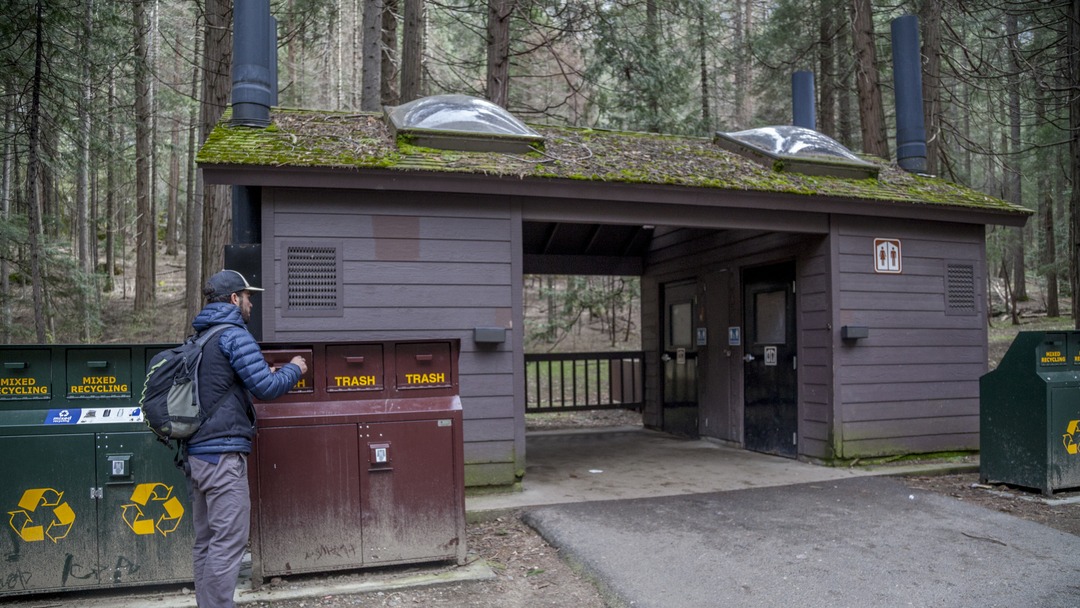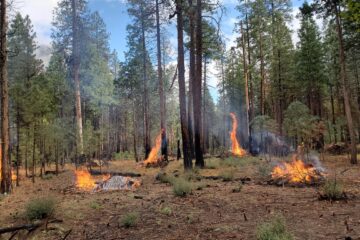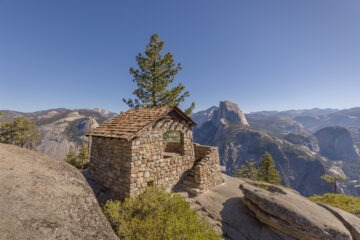It’s inevitable that at some point on your trip to Yosemite National Park, you’ll need to use the restroom. Luckily, there are more bathrooms in Yosemite than we can count — including in campgrounds, visitor centers, and along major trails.
But what happens when a restroom is closed? The National Park Service will likely be understaffed in the summer of 2025 due to ongoing federal policy changes, which could affect how many bathrooms in Yosemite are open. And what about when you’re nowhere near a restroom while out on a trail or in the backcountry?
The trick is to be prepared! Use this blog to make sure you can locate the nearest restroom, have a plan for the backcountry, and recreate responsibly!
Finding Bathrooms in Yosemite Valley
Pretty much anywhere you go in Yosemite Valley, you’ll be within a mile of the nearest restroom. You can expect to find some kind of toilet at trailheads, popular lookouts, and the main eatery areas:
 The Royal Flush:
The Royal Flush:
These porcelain beauties have water that flush away your refuse. These bathrooms often have running water and therefore are also likely to have sinks (and soap) for you to wash your hands.
 The Pit of Relief:
The Pit of Relief:
Next up are the classic pit toilets. These toilets sit above a large cavity that slowly fills over time. These toilets are NOT trashcans. The contents are composted, so only things you would normally flush down the toilet should go into a pit toilet. Sometimes you’ll be lucky and find a hand sanitizer station in this commode, sometimes less lucky.
 The Backcountry Facili-trees:
The Backcountry Facili-trees:
You’re on the trail, miles away from civilization and Mother Nature’s got you covered. This should NEVER be your toilet choice in Yosemite Valley — there are plenty of actual restroom options and far too many people in the Valley for this to be a sustainable option. You should absolutely not be trail pooping in the Valley.
Use the map below to locate the toilets closest to where you’ll be spending time in the Valley.
While not marked on this map, there are also a variety of bathrooms in Yosemite Valley’s four campgrounds and three hotels. Also not on this map, are all of the park restrooms that are located outside of the Valley (i.e., Tuolumne Meadows, Wawona, and the park’s wilderness). You can use this online map or download the NPS App on your phone to locate non-Valley bathrooms in Yosemite.
Plan for the Unexpected (a.k.a. no restroom nearby)
It’s important for visitors to come to the park with a flexible mindset and a backup plan if something goes wrong — and this also applies to having a restroom plan!
If you’re in Yosemite Valley or in another popular frontcountry spot in the park, there will likely be a toilet somewhere pretty close by. Use the tips from the previous section to find your closest option.
Of course, if you’re in double digits of a hiking or backpacking trip, your toilet options change drastically. While there may be pit toilets in the backcountry, there’s a high chance you might need to poop outside while backpacking. In these moments, it’s important to know how to safely poop in the great outdoors. Our favorite way to be prepared is keeping the P.O.O.P. acronym in mind when planning summer trips to the park.
Plan ahead: Know where all the toilets are on your route before heading out on the trail. A little planning can spare you a lot of discomfort (and protect the park’s wilderness too!). We also suggest packing toilet paper, a pooping trowel, hand sanitizer, and a plastic bag just in case.
Opt for toilets: If you’re within range of a restroom, try to make it there! It’s always the best option when nature calls — for you and the park’s landscapes, and plant and animal communities.
Only poop outside responsibly: If you can’t get to a toilet, please follow the leave no trace guidelines for pooping outdoors. You must dig a hole (known as a cathole) that is at least 6 inches deep and at least 100 feet (approximately 40 normal steps) from water, trails, and campsites. If you didn’t bring a trowel, find a nearby rock or stick to dig with. Cover and disguise the cathole when finished.
Pack it out: When pooping outside, (in a hole at least 6 inches deep!) remember to put all used toilet paper in a plastic bag and pack it out with you — toilet paper takes longer to decompose, so packing it out is essential to minimizing your impact on the outdoors. It’s also imperative that you remember to cover the cathole with dirt and use hand sanitizer.
Not interested in digging a hole? Purchase and bring a WAG Bag with you. WAG Bags are portable toilet kits that have a gelling agent that traps, deodorizes, and breaks down waste. Like toilet paper, WAG Bags shouldn’t be left in the wilderness, instead they should be sealed, carried out, and disposed of in a trash can.

The restroom and garbage/recycling facilities at the Bridalveil Fall parking area, before restoration in 2019–2023. Photo by Yosemite Conservancy/Keith Walklet.
Recreate Responsibly
Acting as a responsible park visitor goes far beyond bathrooms in Yosemite. Please follow all leave no trace principles to minimize your impact on Yosemite. This includes parking cars in designated parking spots; properly storing food; not approaching or feeding wildlife; staying on trail; packing out trash; and more.
Looking for more information on how Yosemite is operating in 2025? Check out Yosemite Conservancy’s Know Before You Go blog.



